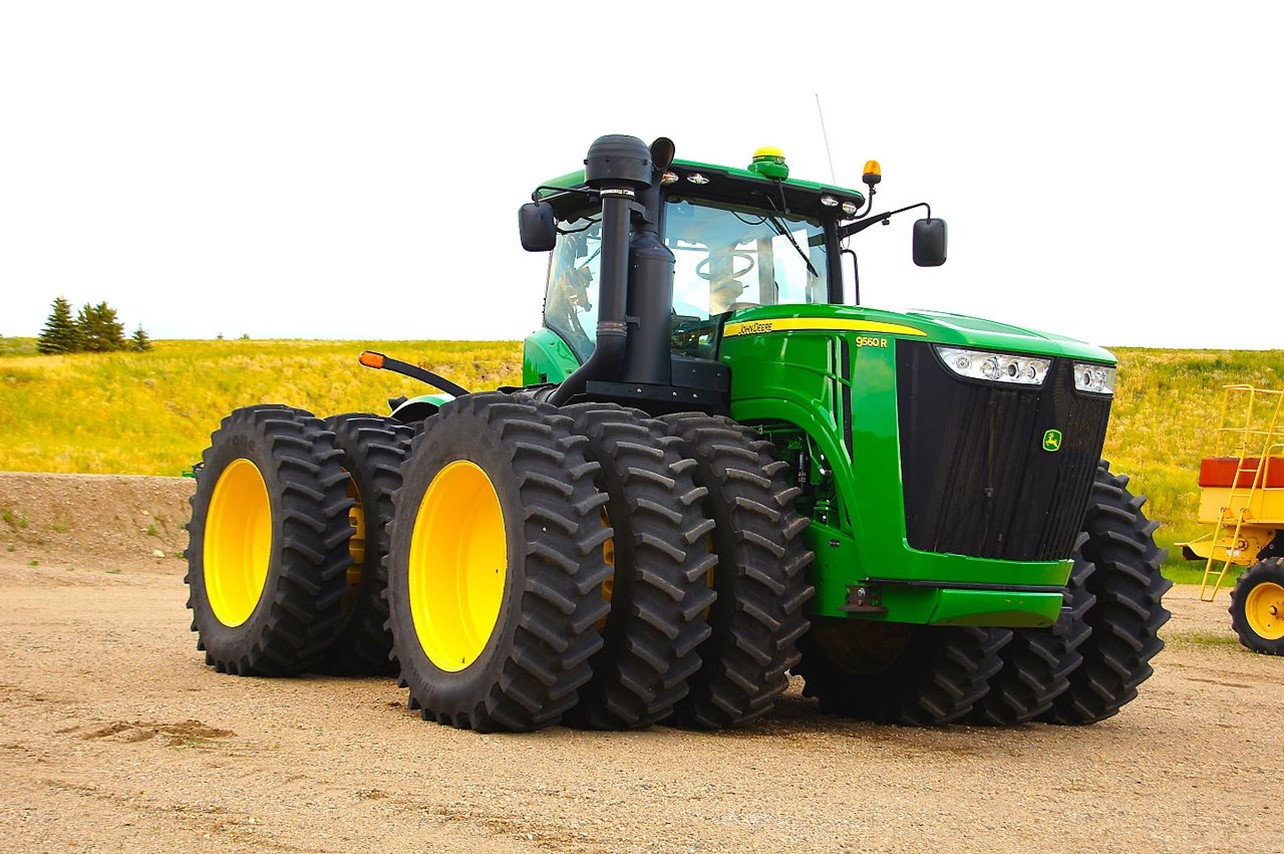
Credit: Madereugeneandrew, via Wikimedia Commons
Heavy farm equipment is now as heavy as the heaviest dinosaurs—and, surprisingly, there may be some similarities.
Today, a fully loaded combine weighs 60,000 pounds—or more!
Engineers have worked to distribute their increasing weight across the soil, widening the tires, sometimes putting three tires on each hub.
But research has shown these heavier machines compact not just the tilled topsoil but soil far beneath it, into the root zones of crops.
This heavy compaction can destroy soil structure: the pores of air space, fungi, insects, earthworms, and beneficial microbes that are essential to soil health and thriving plants. And this damage can persist for decades.
Likewise, the heaviest dinosaurs, tromping through vegetated areas for millions of years, must have compacted those soils, hampering growth of the food they depended on.
Scientists think their long necks may have been an adaptation to help them stay on established pathways and reach into untouched vegetation—much like elephants do today.
We may never know, but modern farmers are looking for machinery solutions that don’t compact the soil as much. They probably won’t have long necks—but they probably will stick to defined paths.
The most likely solution may be fleets of small robotic tractors, controlled remotely by one operator or autonomously, keeping to set patterns.
The farms of the future, informed by the giants of the past.
Background
Synopsis: Today, farm machinery has grown to the size of sauropod dinosaurs. This heavy equipment can take its toll on the soil that crops depend upon, crushing the essential pore space plants require for healthy root development deep below the tilled soil. Farm equipment has evolved along a similar weight to footprint trajectory as sauropod dinosaurs did, so dinosaurs must have compacted soils also. As a silver lining, smaller robotic tractors confined to controlled tracks may one day replace heavier equipment to prevent soil degradation, reduce energy consumption, and further improve agricultural production.
- In the 1850’s, more than two-thirds of Americans worked on farms, but today less than 2% of Americans are farmers.
- In the 1950’s, farms started merging and growing in size, and so did farm equipment, decreasing manpower requirements while improving crop yields.
- By the late 1960’s, most farmers used tractors like the Ford 5000 that weighed just over 5,360 lbs (2.68 tons) for multiple tasks around the farm.
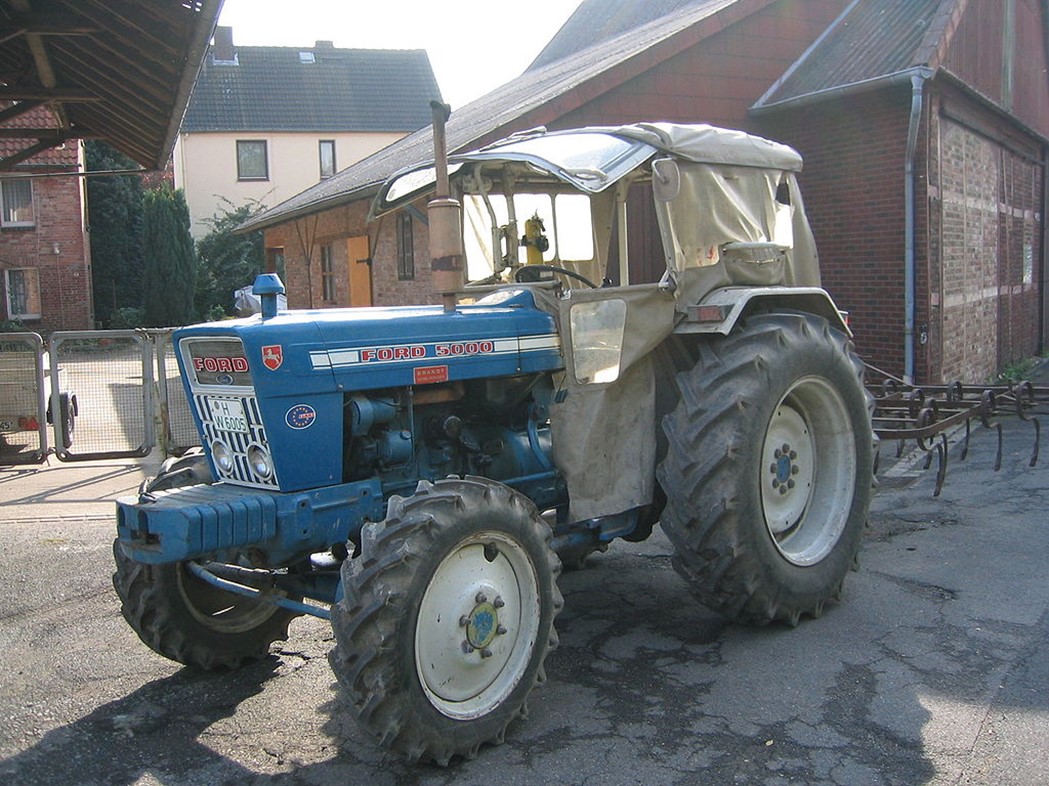
From 1968 to 1972, the 2.68 ton Ford 5000 was one of the world’s most popular tractors.
Credit: Fuchs1978, via Wikimedia Commons - Modern mechanization has helped to multiply production capacity by increasing the size and weight of farm equipment to the point that some machines rival the weight of sauropods (saurischian dinosaurs).
- At weights of 20 to 40 tons, damage to precious agricultural soil becomes a concern for farmers. When farm machinery sinks into soil, it may compact fragile soil structure, collapsing the microscopic scaffolding that supports soil pore space.
- We described how soils form from rocks in ED-029 Digging Soil.
- Soil pores are typically filled with air, water, insects, arthropods, fungi and microbes that encourage healthy root development. We explained the symbiosis of soil fungi and plants in ED-089 The Secret Life of Soil.
- Since the 1960’s, farmers have noted chronic compaction and loss of productivity in both tilled soil and in the subsoil that occurs below tillage depths.
- Root growth below tilling depth is limited where fragile subsoil structure is compacted.
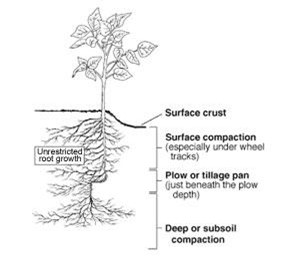
Reduced root growth from wheel track compaction illustrated on right side, with unrestricted root growth illustrated on the left.
Credit: University of Minnesota Extension
- For this reason, farm equipment is deliberately designed to optimize ground contact pressure by using wider tires to spread out the load, with the goal that the equipment “floats” on the soil.
- Therefore, increase in vehicle size has followed a constant contact area to mass relationship as designers strive to minimize surface soil damage.
- This often includes doubling or tripling the huge tires on each hub especially for working in wet conditions when soils are prone to greater compaction.
- However, recent research has shown that even if equipment designers achieve constant surface contact stresses, compaction deep below tillage depths may irreversibly damage subsoil structure in the root zone and potentially reduce crop productivity for decades.
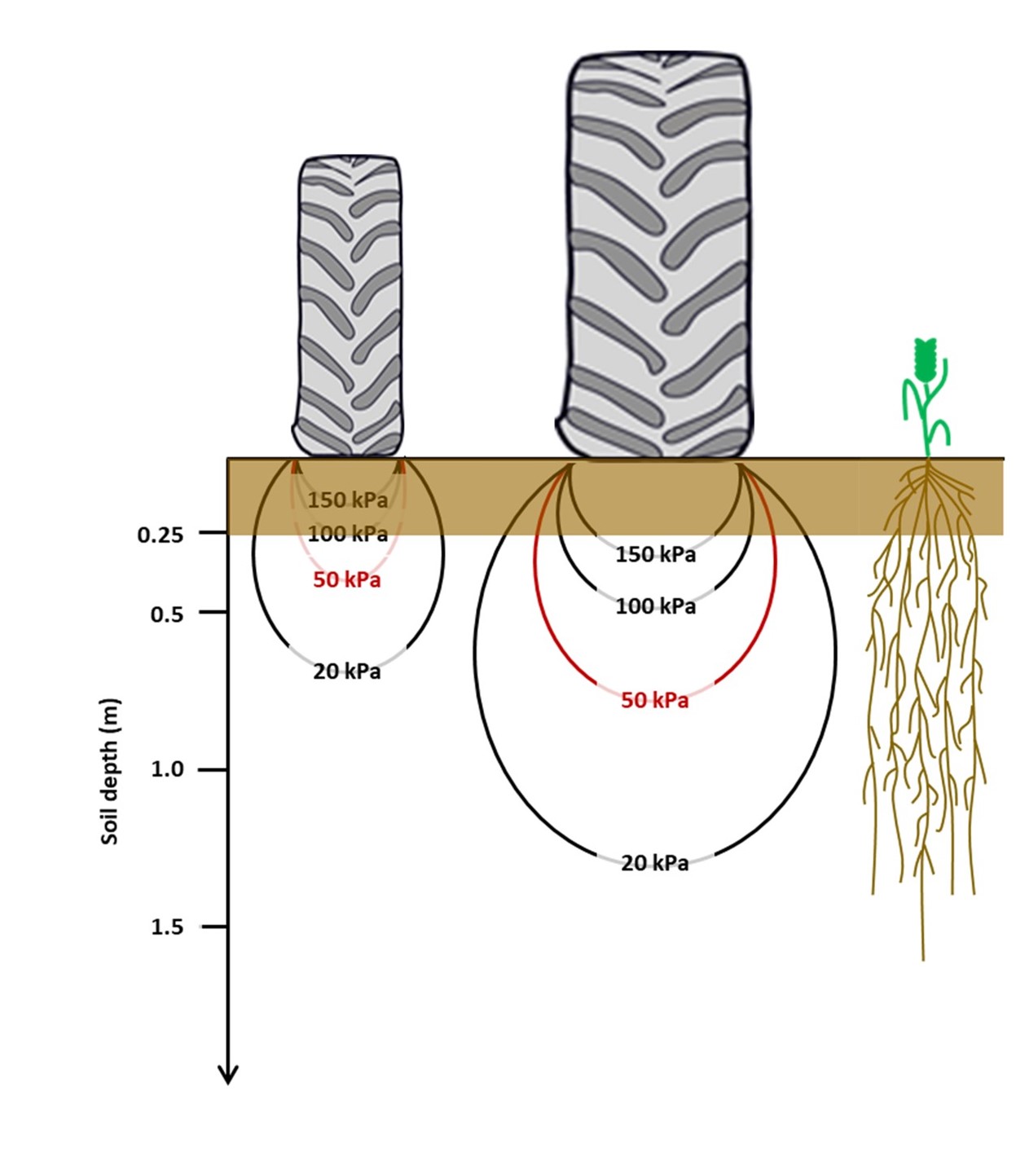
Simulated vertical soil stress below a wheel load of 2.2 tons (1960’s example 2,000 kilograms, left) and 8.8 tons (2000’s example 8,000 kilograms, right) with the same ground contact pressure of 230 kilopascals in both cases. Stress level propagates into deeper soil layers under the higher load, despite equal ground pressure. The root system of a wheat crop (Triticum L.) at harvest is shown for comparison. The brown soil layer (0–0.25 meters depth) represents the annually tilled topsoil. Compacted subsoil (in white) has limited natural recovery potential.
Credit: Keller and Or, PNAS 2022 - But here is an enigma to consider: if tractors that have grown to the size of sauropods can damage soil for decades, how would sauntering gigantic sauropods have impacted the soils that supported their food sources in their habitats over millions of years?

Size comparison of selected giant sauropod dinosaurs, some weighing up to 40 tons.
Credit: KoprX, via Wikimedia Commons- Sauropods trampled Earth’s surface for about 162 million years, from the Late Triassic Epoch to the Late Cretaceous Epoch, with fossils occurring on all seven continents.
- By the Late Jurassic Epoch, species like Brachiosaurus and Diplodocus had become widespread, and, by the Late Cretaceous Epoch, Titanosaurus had a near global distribution.
- Like farm equipment, sauropods and most other animals also follow a fairly constant contact area to mass relationship—as they increase in size, they require larger feet for support, especially in soft soil or mud. This is dictated by soil mechanical properties.
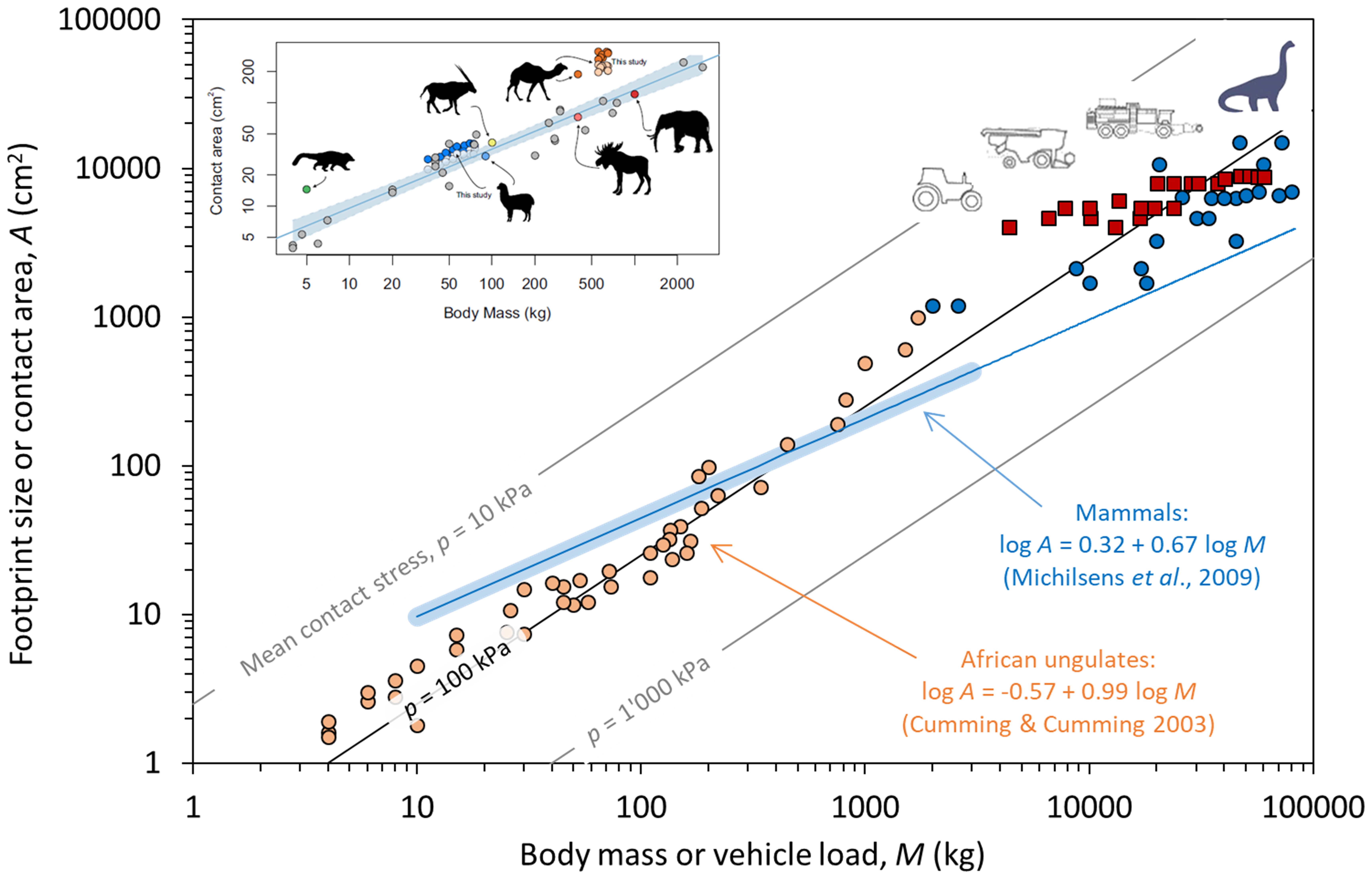
Scaling relationship between footprint size (contact area) and body or vehicle mass. Blue circles represent sauropods and red squares represent agricultural machinery. The orange circles and blue lines represent mammals. Note the relatively narrow range of surface contact stress that spans the entire range of animals (extant and extinct) and agricultural machinery. Each 1M (or 1000) kilogram is the equivalent of 1.1 US tons.
Credit: Keller and Or, PNAS 2022- With saurischian dinosaurs stomping around the globe on their 2.5 to 4.5 ft (0.75–1.4 m) long feet for millions of years, soil structure must have been in peril, and with it, habitat productivity.
- This must have constrained sauropod foraging patterns, habitats and migration.
- We will probably never know, but maybe their long necks enabled them to use established trackways along the peripheries of feeding areas they stretched to reach, similar to modern elephant trails.
- There may be a silver lining solution on the horizon for farm equipment.
In the future, gargantuan farm machinery may be replaced by fleets of lightweight GPS-guided autonomous tractors—agricultural robots—that can be driven remotely by fewer operators along specified tracks to mitigate soil degradation while maintaining agricultural productivity. You can see an autonomous tractor video here.

Credit: ASIrobots, via Wikimedia Commons

